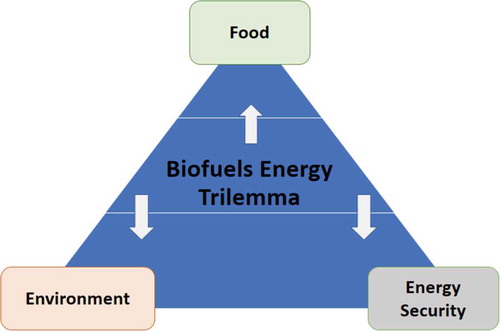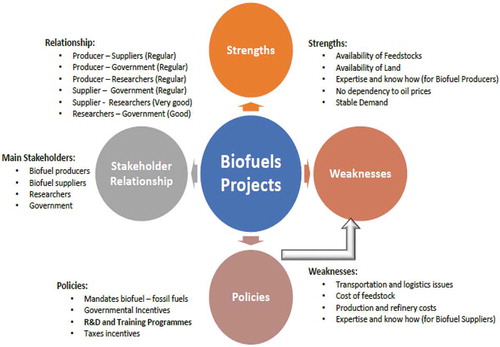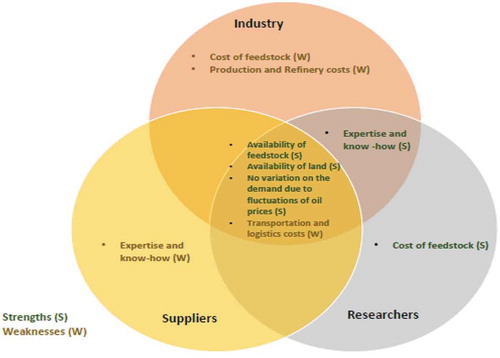Abstract
Different efforts have been carried out in the last years in order to find some alternatives for fossil fuels. Biofuels have been considered as one of the possible substitutes for fossil fuels because the majority of vehicles and co-generation systems can use them without any modification and produce fewer emissions. Additionally, some developing countries are presented as a good location for biofuels production due to their weather, economic and social conditions. The methodology used in this study is as follows: firstly, the current drivers and barriers that affect the production of biofuels in Colombia were identified in the available literature. The results showed Colombia presents some special conditions for the production of biofuels that allow it to generate a competitive advantage compared to other countries. However, some barriers can affect the adoption and production of biofuels in the country. Secondly, a survey was realised to biofuel producers, suppliers and researchers in order to validate their motivations and perceptions. Some similitudes and differences with regard to the literature were found in the surveys. Hence, this information allowed the authors to understand the reality of biofuels in Colombia from the views of the stakeholders. Additionally, a set of policies were analysed. The authors believe that this set of policies will help stakeholders to have a better production of biofuels in Colombia.
PUBLIC INTEREST STATEMENT
Biofuels, any fuel that is derived from biomass: plant or algae material or animal waste, have been considered as one of the possible substitutes for fossil fuels as the majority of vehicles and co-generation systems can use biofuels without any modification and produce fewer emissions. On the other hand, this can be a good opportunity for some developing countries as they have a good location for biofuels production due to their weather, economic and social conditions.
This study is based on available information in the public domain and survey made to several stakeholder in the bioenergy sector in Colombia so that the current drivers and barriers that affect the production of biofuels can be identified. There is a big opportunity for biofuel production leading to an economic growth; however, a set of policies needs to be developed and deployed to facilitate this.
1. Introduction
Bioenergy, i.e. biofuels, will play an important role in the next years. Today, the different types of biofuels represent 3% of the total road transport fuel around the world, and it is predicted that by the end of 2050, biofuels will represent 27% of the total transport fuel (International Energy Agency, Citation2011). Therefore, many countries in European Union (EU) and some developing countries have started to promote this kind of energy in order to achieve some competitive advantage over other countries. Moreover, countries that start with the production of biofuels will have less dependency on fossil fuels (Koh & Ghazoul, Citation2008; Ryan et al., Citation2006). However, some barriers and challenges need to be addressed in order to get a viable implementation of biofuels. Economic, social, political, and environmental aspects can support or affect the production of biofuels (Gunningham, Citation2013). The different barriers that need to be addressed are known as the energy trilemma in energy transitions projects (Stansfield et al., Citation2016).
The transitions to renewable energies such as biofuels require strong involvement of the different actors to achieve a sustainable adoption that benefits the different stakeholders who have to manage new challenges in political, social, and economic areas (Gunningham, Citation2013; Stansfield et al., Citation2016). Figure shows a trilemma model for the case of biofuels where it is necessary to find a balance between the different areas to reach a sustainable implementation of biofuels.
The first aspect is related to the food threat (Gunningham, Citation2013; Tilman et al., Citation2009). The demand for food is increasing due to the rise in the population (Turcksin et al., Citation2011). However, the use of land and workforce for biofuel production can increase the price of food generating inequity and social injustice. Then, it is necessary to find a way to mitigate the impact on food prices.
The second corner is the environment (Gunningham, Citation2013; Tilman et al., Citation2009). Biofuels are presented as the best alternative to avoid the dependency of oil production. Moreover, they have the facility of being a 100% substitute for fossil fuels or can be blended with a percentage of traditional fuels. In addition, biofuels have environmental benefits; they can reduce the levels of carbon dioxide emissions and therefore they can improve the air quality (Woods et al., Citation2006). Nevertheless, a non-professional production can generate a high consumption of water, and it can cause erosion in the process to harvest feedstock for biofuels.
Finally, the third corner is energy security (Tilman et al., Citation2009). The implementation of new energies should be easy to access by final users (Gunningham, Citation2013). Thus, there should be an affordable price that allows supplying the energy needs of the citizens. For that reason, biofuels must become economically competitive regarding gasoline to be considered as a reasonable alternative.
Rather than solving all the problems of the trilemma, it is important to manage the complexity that is generated in order to create a balance between production and implementation of biofuels leading to benefits for the key players. As a result, it is crucial to analyse the interest, policies of each of the stakeholder group due to they will have different interests related to the economic, environmental and social aspect of bioenergy projects (Röder, Citation2016; Schillo et al., Citation2017), and their differences can affect the success of biofuel projects.
Therefore, it is crucial to examine the viability of the biofuel production in Colombia. It is important to evaluate many aspects to reach the feasibility of the business considering the cost associated with the production of biofuels because it must be not only sustainable in terms of environmental and social benefits but also in economic aspects. In addition, it is essential to analyse the perceptions of the stakeholders as their interest and attitudes are critical for the biofuel production chain (Mohr & Raman, Citation2013).
2. Literature review
Currently, Colombia produces two types of biofuels: bioethanol and biodiesel. At the same time, Colombia places its production in two types of feedstock: sugar cane and palm oil. Regarding capacity in Colombia, 1.1 million litres of bioethanol per day and 1.7 million litres of biodiesel per day are being produced. It is estimated that biofuels are generating nearly 25,000 direct jobs and 48,000 indirect jobs (Federación Nacional de Biocombustibles de Colombia, Citation2017a, Citation2017b) which is a key factor in order to promote and continue with the development of biofuels in Colombia.
In 2015, Colombia produced 456 million litres of bioethanol and as is shown in Table , this value has increased in the last eight years and it is expected that in the next five years the production of bioethanol in Colombia continues growing to satisfy the local demand.
Table 1. Production of bioethanol in Colombia in the last eight years. Source: (Federación Nacional de Biocombustibles de Colombia, Citation2017a)
As shown in Table , there are eight bioethanol plants in Colombia, which are producing nearly 2 million of litres of bioethanol per day. One of the main benefits that permit to reduce the price of bioethanol and facilitate the logistic and supply chain of biofuels is the location of the harvesting crops. The majority of feedstock suppliers are located in the states of Cauca and Cauca Valley close to the refineries of bioethanol (Federación Nacional de Biocombustibles de Colombia, Citation2017a; Ministry of Mines and Energy & Inter-American Development Bank, 2010). This generates a competitive advantage compared to other cases where the logistics and transportation of the raw material increase the final cost of biofuels.
Table 2. Bioethanol plants in Colombia. Source: (Federación Nacional de Biocombustibles de Colombia, Citation2017a)
In addition, Colombia has one the best average yield of sugar cane production as presented in Figure . The locations are the main reasons that permit to generate a good yield in Colombia because the tropical and equatorial weather produce better fertile soil conditions, which improve the harvesting yield.
There are many benefits related to a good yield in the production of biofuels. A better yield means that the farmer will have the possibility to get more sugar cane crops on less land, bringing benefits not only to the farmers but also to the industry because they will have more available crops to produce bioethanol reducing the price of the raw material.
Figure 2. Average yield of sugarcane in some countries. Source: (Ministry of mines and energy & inter-American development bank, 2010)
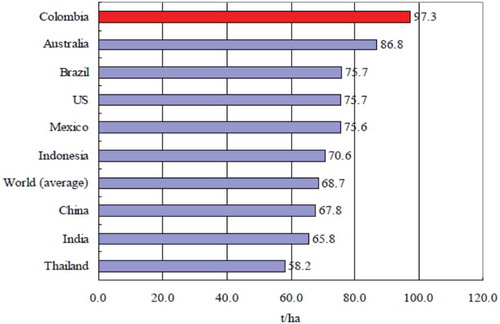
Another factor that it is important to analyse is the price of bioethanol and how it has fluctuated in the past years. As shown in Figure , the prices of bioethanol have changed in the last 8 years. These prices have changed due to different factors such as the availability of raw material and the increase of the demand (Tao & Aden, Citation2009). Furthermore, it can be seen that the price of gasoline, ethanol and bioethanol are very similar; therefore, the industry of biofuels in Colombia has a big challenge related to the cost of production of bioethanol.
Figure 3. Ethanol prices in the past seven years. Source: (Federación Nacional de Biocombustibles de Colombia, Citation2017c)
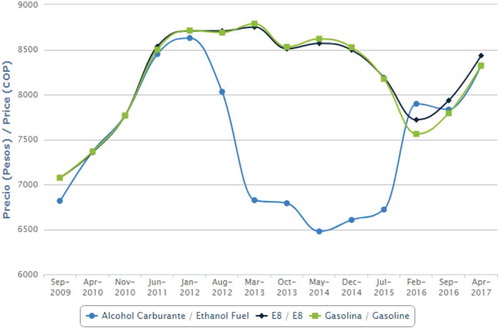
Even though the use of the bioethanol brings additional benefits compared to the gasoline, it is important to have an economic benefit to promote the adoption of this kind of biofuel. The main reason for the increase in the price of ethanol compared to the last three years is related to the price of raw material because the production of sugar cane has increased in the past years in Colombia that has affected the price of bioethanol in the country. Moreover, a reduction in the production of sugar cane due to weather conditions has increased the price of the raw material affecting the final price of bioethanol (Colprensa, Citation2017).
On the other hand, in the year 2016, Colombia produced 447,768 tons of biodiesel. As observed in Table , Colombia has tripled the production of biodiesel in the last eight years; the increase in the production has been related to the rising amount of new plants in the last years.
Table 3. Annual production of biodiesel in Colombia since 2008. Source: (Federación Nacional de Biocombustibles de Colombia, Citation2017b)
Colombia has 12 biodiesels plants (please refer to Table ), of them started to operate after 2010, which helped to increase the production of biodiesel to satisfy the local demand.
Table 4. Biodiesel plants in Colombia. Source: (Federación Nacional de Biocombustibles de Colombia, Citation2017b)
Table 5. Number of jobs related to the production of bioethanol. Source: (Federación Nacional de Biocombustibles de Colombia, Citation2017a)
Similar to the yield in the production of sugar cane, the yield of the oil palm is better compared to the other producer countries (see Figure ). As mentioned before, a better yield permits to get more amount of oil palm using fewer resources and less land that can help to mitigate the problem related to the land availability (Harvey & Pilgrim, Citation2011).
Figure 4. Average yield of oil palm production. Source: (Ministry of Mines and Energy & Inter-American Development Bank, 2010)
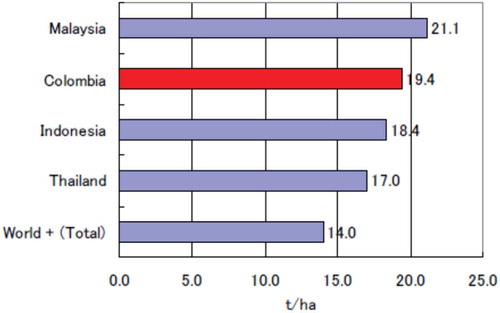
As presented in Figure , the price of biodiesel is higher than the price of diesel. This represents a problem now to incentive the consumption of biodiesel as the customer would prefer to choose the diesel due to its lower price. However, the price of blend biodiesel-diesel is economically competitive compared to the diesel. Therefore, it can mitigate the impact of the price of biodiesel.
Figure 5. Biodiesel prices in the past seven years. Source: (Federación Nacional de Biocombustibles de Colombia, Citation2017d)

In Colombia, the distribution of a blend biodiesel-diesel is mandatory for that reason the distribution and selling of this biofuel are compulsory without considering the price of it. However, it is important to start to reduce the price of the raw material and the price of the production of biodiesel to compete in other markets and other scenarios. It is essential to have a low-cost production of biodiesel to start the process of exportation or in case that the government decide to finish with the mandatory blended policies.
Several studies have researched the main barriers and limitations now to start and expand biofuels projects in different countries. One of the main limitation and barriers that is mentioned as a critical to get a viable and successfully biofuel project is the cost of transportation and logistics of raw material to the bioenergy plants (Upreti, Citation2004). Currently, the majority of the harvesting zones are located close to the refinery plants reducing the logistics and transportation costs. In addition, the time of delivery of the raw material is reduced. However, the potential harvesting zones for future development will be located in other states, which can increase the cost of transportation and time of delivery.
Another barrier that has been studied is the production capacity (Piterou et al., Citation2008). The demand for biofuels has increased in the last years (Sorda et al., Citation2010) and it is expected that the demand for biofuels will increase in the next years (Ministry of Mines and Energy & Inter-American Development Bank, 2010). Even though Colombia has potential land to start with the expansion to increase the availability of feedstock, there are no real plans to carry out this expansion; for that reason, the industry has started to import feedstock to produce biofuels (Economia, Citation2017).
On the other hand, there are no plans to launch an expansion of new refineries of biodiesel and of bioethanol (Agropecuaria, Citation2016) and it can increase the uncertainty about the availability of biofuels in Colombia.
Another critical barrier that can affect the success of biofuels projects is related to the prices of biofuels. The price of diesel is not competitive with the price of biodiesel. The final cost of biodiesel is near 40% more expensive than the price of diesel (Federación Nacional de Biocombustibles de Colombia, Citation2017d) demotivating the adoption of this kind of fuel. Therefore, it is important that the stakeholders involved in the production of biodiesel try to reduce the cost of production to get a competitive price.
In the literature, many drivers have been analysed in order to promote biofuels projects. The majority of these drivers were located in Europe and Asian countries. However, some of the drivers discovered in those countries can be applied to Colombia scenario.
One of the drivers and opportunities that can be applied to Colombia is related to the land availability. There are more than 7 million ha available for harvesting oil palm and sugar cane (Ministry of Mines and Energy & Inter-American Development Bank, 2010). Moreover, the use of this land does not affect the harvest of food crops that reduce risks and uncertainty about the prices of the food. Therefore, the available land in Colombia will permit to increase the production of biofuels to reach the future demand avoiding the competition with the crops for human consumption.
Another driver that has allowed an increase in the production of biofuels is the policies and governmental regulations. The different policies implemented by the Colombian government to increase the demand for biofuel have led the country to be the second largest producer of biofuels in Latin America region and is the top 15 countries around the world. Therefore, the right implementation of governmental policies can motivate the different stakeholders to raise the participation in those kinds of projects.
In addition, technology and know-how are fundamental drivers that permit an acceleration and a more sustainable production of biofuels (Simonin, Citation1999). Colombia has produced oil palm and sugar cane since the 50 s, and the production has become more technical and industrialised since then (Ministry of Mines and Energy & Inter-American Development Bank, 2010). Therefore, the technology that Colombia has developed allows generating a more viable production reducing the cost associated with it. Furthermore, the people involved in the different phases of the supply chain have improved their knowledge leading to a more qualified production that allows competing in any international market.
One of the main opportunities that motivate the stakeholders to participate in biofuels project is the opportunity to create new jobs in all the phases of the supply chain (Panoutsou, Citation2008). For instance, the production of bioethanol has created more than 100,000 jobs in different phases of the supply chain as seen in Table while the production of biodiesel (refer to Table ), nearly 90,000 direct and indirect jobs have been created in different states.
Table 6. Number of jobs related to the production of biodiesel. Source: (Federación Nacional de Biocombustibles de Colombia, Citation2017b)
Finally, weather and soil conditions are considered another driver for Colombia context. Due to the location and weather conditions, in the Cauca Valley and Magdalena region, the yield is higher if compared to other countries (Ministry of Mines and Energy & Inter-American Development Bank, 2010). Hence, the farmers will use less land and fewer resources to get more sugar cane and oil palm, which reduce the price of the raw material and consequently reduce the final price of the biofuels.
The drivers and barriers can affect one or all the actors that participate in the production of biofuels; therefore, it is important to recognise the different stakeholders that participate in biofuels projects. Table shows a list of stakeholders that have been referred by different authors. Industry and biofuel suppliers as the internal stakeholders and researchers and government as external stakeholders have been recognised as the most critical in order to get successful biofuel implementation projects.
Table 7. Classification of stakeholders by different authors. Source: Authors’ own
Communities or farmers are in the first phase of the supply chain as presented in Figure . Therefore, their influence is critical to the success of biofuels projects because they are in charge to provide the necessary feedstock for the production of biofuels (Gold, Citation2011). In the economic aspect, the main concern is related to the profit of the crops (Turcksin et al., Citation2011), then the biofuel feedstock must be economically viable compared to other kinds of crops leading the suppliers to be considered critical to the success of any project (Henriques & Sadorsky, Citation1999).
The biofuel producers are in the second place of the supply chain. Similar to the biomass suppliers their main concern is to generate a consistent profit to cover their investment costs to achieve an economically viable biofuel project (Mayfield et al., Citation2007).
To generate a margin profit, the final production cost should be less expensive than the production cost of fossil fuels. However, when the production cost of biofuel is more expensive, some strategies such as taxes reduction and governmental incentives can compensate the final production cost (Elghali et al., Citation2007). In summary, the producers play a strategic role as the capacity to satisfy the demand depends on them and the final biofuel price is set up based on the process and technology used by biofuel producers.
Researchers in the natural and social sciences play central roles in the creation of technologies and strategies required for successful introduction of new projects (Woods et al., Citation2006). For example, researchers can contribute to the development of new species and cultivation methods to improve the biofuel feedstock. Moreover, they can generate a new and better conversion technology to enhance and reduce the cost of producing biofuels (Woods et al., Citation2006).
Figure 6. Biofuel supply chain with external stakeholders. Source: (Schillo et al., Citation2017)
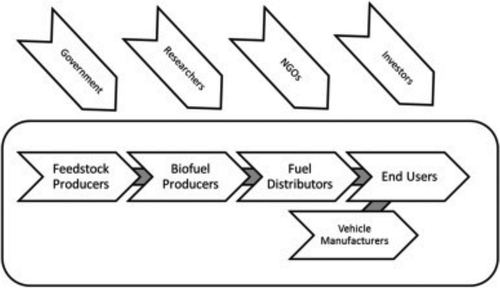
Rather than focusing on the economic aspects of biofuels projects, a key point is the environmental aspects of biofuels (Puy et al., Citation2008). Their main driver for the time being to participate in biofuel is the environmental benefits of this technology. Hence, these aspects need to interact with the majority of stakeholders involve in the process of biofuel production.
Government with the support of researchers are in charge of the legal and policy frameworks to motivate the consumption of biofuels (Holm-Nielsen & Ehimen, Citation2016). Moreover, their decisions and policies can incentive the production of the feedstock and of biofuels (Woods et al., Citation2006). For that reason, the involvement of government is critical and vital to incentive the adoption of biofuels in any country.
The support of the government has been analysed in many renewable projects. In the UK, the government has been pointed out as the leading actor for the deployment of biofuels projects (Evans & Newton-Cross, Citation2016). Therefore, the outcome of these types of projects can generate a positive or negative impact according to the regulation and control of the government (Puy et al., Citation2008).
A limited attention from the government to these new projects can generate a slow deployment of biofuel decreasing the involvement and participation of stakeholders (Elghali et al., Citation2007). The government should support the private sector through a creation of a set of planning decisions and governmental policies, which can lead to best practices so that the financial and social risks will be mitigated (Puy et al., Citation2008). Consequently, the government should create a legal and policy system to support farmers in the production of feedstock through the creation of an agricultural policy that allows the development of rural zones (George, Citation2016). Additionally, the support of the government is essential to achieve the targets of biofuel production (Puy et al., Citation2008). Therefore, it can be said that the decisions and participation of the government are critical to the success of these kinds of projects and for that reason, people perceive government as one of the most influential stakeholders at the moment to lead the development of new technologies (Evans & Newton-Cross, Citation2016).
Figure shows other stakeholders that can play a role in the deployment of biofuels. NGOs and end users are the most studied in the literature (Reed, Citation2008). Final consumers as in the majority of biofuel projects are essential to increase the deployment of biofuels (Kumar et al., Citation2006). Customers are directly related to the demand for biofuels; their attitude towards it can increase or decrease the production of biofuels. Hence, the perceptions of consumers can generate resistance towards the deployment of biofuels. The price of biofuels should be competitive if compared to the price of fossil fuels to attract the final consumers. Then, it is important that users are aware of the benefits of biofuels leading to a higher adoption of them. Thus, to increase the acceptance of biofuels by the society, they should understand the importance of environmental benefits in the long term.
3. Experimental setup description and results
3.1. Description of the experimental setup
To know the perceptions of different stakeholders, some questionnaires were used. The design of these questionnaires was based on a qualitative approach to have the possibility of hearing the opinion of the actors related to biofuels in Colombia.
The design of the questionnaires was based on the opportunities and barriers that the stakeholders face to implement biofuel projects. The opinion of the stakeholders is critical in order to get a viable project of biofuels. In these sorts of projects, many stakeholders arise (Darshini et al., Citation2013). However, for this research, three critical stakeholders were evaluated, and the surveys were designed for these three group of people. Researchers, communities and industry representatives are considered the most important stakeholders because they have a direct influence in the process and implementation of biofuels. Moreover, their perceptions can have a direct influence on the viability of these projects (Darmaki & Rashed, Citation2015; Darshini et al., Citation2013).
The questions were set up based on the needs of the stakeholders (i.e. their views, advantages, and disadvantages that were identified in the literature for every group of stakeholders). In that way, the participants of the questionnaires were asked to evaluate the importance of different benefits and barriers. In addition, they were asked about the governmental policies and the future scenarios in order to comprehend the feasibility of those projects in Colombia.
At the end, 37 stakeholders replied the survey, 75% of the respondents held positions in the academic and research sector, while the rest 25% of the respondents were distributed between producers of oil palm and sugar cane and producers of bioethanol and biodiesel.
A single choice of method collection is not enough because it is necessary to validate the data obtained from questionnaires. For that reason, literature review was chosen as the second source of data collection. To investigate the barriers and identify the advantages and opportunities of biofuels projects were necessary to review different articles and studies that mention the advantages and disadvantages of biofuels projects in other countries around the world.
The review of the information available in the public domain allows a deep understating of the actual situation supporting the primary data collection method based on questionnaires.
3.2. Results
The results show that economic benefits are one of the most important aspects that motivate the participation of producers and suppliers in biofuel projects as is depicted in Figure . Therefore, it is important that stakeholders can generate profit when they are participating in biofuel projects as without an economic incentive, the participation of the stakeholders will decrease.
In addition, the environmental benefits were mentioned as another key driver, especially for researchers that have participated in biofuels projects. The difference about the primary factor of motivation between researchers and producers/suppliers can be explained as the researchers´ participation in these projects is not driven by a finance motivation. Their primary goal is to generate a right knowledge that benefits the majority of the population. For example, the availability of land for harvesting crops and consequently availability of feedstock for current and future demand. Those two factors allow a sustainable production and reduce the risk due to non-availability of supply material.
Another observation is that the independence between the demand of biofuels and the prices of fossil fuels for the case of Colombia is considered another strength. The demand for biofuels in Colombia has a stable behaviour regardless external factors, which can be attractive for the producers and suppliers that are involved in the production of biofuels.
The expertise and know-how to produce biofuels in the country were considered a strength, which represents more than 20 years (refer to Figures and ). Regarding the weaknesses, the cost of feedstock will have a higher impact as it contributes to 50-70% of the final price of biofuels (Holm-Nielsen & Ehimen, Citation2016). In addition, Figure displays the different policies that can help to alleviate the impact of the weaknesses, for example, the implementation of subsidies can be an ideal policy to mitigate the economic impact of the costs of feedstock and refinery process.
The lack of expertise and know-how of suppliers can be solved with the implementation of training policies to allow to the different suppliers generate a sustainable and more efficient production of sugar cane or oil palm. Moreover, better training for the production of the raw material can reduce the price of the feedstock and generate a more efficient production of feedstock. For that reason, at this point, it is essential the participation of government, researchers and suppliers to create a unified knowledge that produce benefit for the participants of those projects. Another critical point to be considered is the relationship between stakeholders as a poor interaction and communication between them can lead to an adverse outcome in biofuel projects .
3.3. Results analysis
The results confirm that Colombia presents a competitive advantage compared to other countries. The availability of land and feedstock can generate a benefit for future scenarios when the demand for biofuels tend to increase (Castiblanco et al., Citation2015). Some studies have shown that the use of feedstock for biofuel purpose can increase the price of food for human consumption (Röder, Citation2016; Zilberman et al., Citation2013). Nevertheless, the availability of land in Colombia will allow decreasing the threat with regard to this issue. In that way, the availability of land and feedstock will help to deal with the first corner of the energy trilemma related to the food price (Gunningham, Citation2013; Tilman et al., Citation2009). For that reason, Colombia should continue investing in those types of projects as it has the needed resources to become a leading producer country of biofuels without generating impact on the prices of food.
The majority of stakeholders perceive that the demand has not decreased in the last months. The results showed that in Colombia there is no relationship between the demand for biofuels and the oil and gas prices. This phenomenon can be explained by the adoption of some policies in the country related to the mandatory distribution of biofuels (Balat, Citation2007). Therefore, it is vital the implementation of these types of policies to keep a constant demand for biofuel regardless of the external variables leading to better economic benefits for the different stakeholders.
One of the benefits of Colombia related to the production of biofuels is the location of the harvesting zone (Ministry of Mines and Energy & Inter-American Development Bank, 2010). The majority of the sites are close to the refineries and production plants, which represent a competitive advantage compared to other countries. Nonetheless, the different stakeholders expressed their concerns about the location of the harvesting zones, especially for a future expansion.
One issue that was highlighted by some of the stakeholders is related to the social conflicts in some harvesting locations in Colombia. Communities and industry have to deal with illegal groups in those zones. Therefore, it is important that the different stakeholders pay attention to the additional factors that are unknown or with low importance in other countries when they start with the expansion of land for future production of biofuels.
To deal with the weaknesses, there is an agreement with the existing knowledge (Koizumi & Ohga, Citation2007; Sorda et al., Citation2010). This research showed the importance of the policies to motivate and increase the adoption of biofuels in the country. The implementation of R&D and training programs has not been widely discussed in the literature (Sorda et al., Citation2010). Nevertheless, the questionnaires revealed the importance of this policy to create a better knowledge among the biofuel suppliers. A proper implementation of R&D and training programs help to generate a more sustainable production of feedstock. Hence, the support of researchers to avoid the erosion and a negative impact in the ecosystem will allow creating a friendlier environmental production of sugar cane and oil palm (second corner of the energy trilemma related to environmental problems) (Tilman et al., Citation2009).
The third corner of the energy trilemma is energy security (Gunningham, Citation2013; Tilman et al., Citation2009). The price of biofuels should be economically accessible to the citizens. The price of bioethanol in Colombia is 5% higher compared to gasoline (Federación Nacional de Biocombustibles de Colombia, Citation2017d), and the price of biodiesel is 30% higher compared to the price of diesel (Federación Nacional de Biocombustibles de Colombia, Citation2017d). The results showed that the cost of feedstock and the production and refinery costs are some factors that affect the final price of biodiesel and bioethanol. These results confirm what it is said by some authors about the 45%-80% of the cost of biofuels depends on the cost of feedstock claim (Ewing & Msangi, Citation2009; Fatih Demirbas, Citation2009). Therefore, stakeholders need to be aware of these costs in order to generate a viable production of biofuels. In this aspect, the support of the government is essential (Evans & Newton-Cross, Citation2016; George, Citation2016) as their decisions can help to mitigate the impact on the final price of biofuels. Subsidies to support the production cost can arise as an alternative to alleviate the costs of biofuels. Furthermore, the possibility to blend biofuels with fossil fuels could be a viable solution to decrease the final price of biofuels without compromising the environmental benefits of biofuels.
General speaking, the results confirmed the importance of biofuel industry, suppliers, and government as critical stakeholders to support the development of biofuel projects (Darshini et al., Citation2013; Freeman, Citation2015). However, in Colombia, the role of the government is not widely valued by the different stakeholders. Producers and suppliers claimed that the participation of government is not important for the development of biofuels. However, they expressed that the relationship with the governmental body is regular. As a result, the involvement of the government is essential to support the deployment of new energy projects (Evans & Newton-Cross, Citation2016). Thus, the different actors should pay more attention to the role of the government and the relationship with it as the absence of the government is affecting the relationship with the different stakeholders leading to a poor development of biofuels in Colombia.
4. Conclusions
Firstly, it was found that the availability of the land, weather and soil conditions improve the production of biofuels in Colombia. In addition, the technology and know-how that has been acquired in the past 20 years and the possibility to generate new jobs are considered other types of drivers that help to generate successful biofuels projects. Secondly, some barriers that affect the viability of biofuels were identified. Colombia has available land for future expansion; however, this land is far from the refinery leading to uncertainties about future logistics and transportation costs. Additionally, the limitations of infrastructure for future demand can affect the development of biofuels, and the cost of biofuels was considered as the main economic barrier that can influence the adoption of biofuels in the country.
Lastly, the study pointed out the need to improve the relationship between stakeholders to avoid a negative outcome of biofuels projects. Therefore, this framework highlighted the importance to improve the relationship with the government, which is a critical stakeholder to promote the production of biofuels via policies and regulations.
Acknowledgements
The authors acknowledge the financial support received from the Universidad Cooperativa de Colombia (UCC), and COST Actions CA17128 “LignoCOST” and CA17133 “Implementing nature-based solutions for creating a resourceful circular city” for their support and encouragement in carrying out scientific networking. Support and guidance from Warwick University and Institute of Physical Chemistry of the Polish Academy of Sciences are also acknowledged.
Additional information
Funding
Notes on contributors

Ramón Fernando Colmenares-Quintero
Ramón Fernando Colmenares-Quintero is currently national head of research in engineering and Professor Dr. at the Universidad Cooperativa de Colombia (UCC) with research focus on energy generation, simulation and modelling in the energy sector and multi-objective optimisation for renewable energy systems and sustainable communities.
Camilo José Rico-Cruz
Camilo José Rico-Cruz obtained an MSc in Engineering Business Management at Warwick University. His interest is in bioenergy system tecno-economical assessments and business models.
Kim E. Stansfield
Kim E. Stansfield got a PhD in Composites from Kingston University. He was sustainable energy systems transformation planner at the UK Energy Technologies Institute. Joined Warwick WMG in 2016 as lecturer. His interest is in the community voice transformation into sustainable energy system.
Juan Carlos Colmenares-Quintero
Juan Carlos Colmenares-Quintero obtained his M.Sc. (1997) and Ph.D. (2004) in Chemical and Material Sciences from Warsaw University of Technology, and a D.Sc. (2015) from the Institute of Physical Chemistry in Poland. His interests range from nanotechnology, and heterogeneous catalysis to biomass/CO2 valorisation, solar chemicals, sonication, photocatalysis, and water/air purification.
References
- Agropecuaria, R. (2016). Inversiones en plantas de etanol y biodiesel en riesgo: Fedepalma. Vanguardia. http://www.vanguardia.com/economia/nacional/376245-inversiones-en-plantas-de-etanol-y-biodiesel-en-riesgo-fedepalma
- Balat, M. (2007). An overview of biofuels and policies in the European Union. Energy Sources, Part B: Economics, Planning, and Policy, 2(2), 167–18. https://doi.org/10.1080/15567240500402701
- Castiblanco, C., Moreno, A., & Etter, A. (2015). Impact of policies and subsidies in agribusiness: The case of oil palm and biofuels in Colombia. Energy Economics, 49, 676–686. https://doi.org/10.1016/j.eneco.2015.02.025
- Colprensa. (2017). Se suspende 90% de la cosecha de caña por invierno en Colombia. El Colombiano. http://www.elcolombiano.com/negocios/economia/se-suspende-90-de-la-cosecha-de-cana-por-invierno-en-colombia-NB6542690
- Darmaki, A., & Rashed, A. (2015). A systematic analysis of strategic planning key success factors and its required professional skills-case study of Abu Dhabi. International Journal of Sales.
- Darshini, D., Dwivedi, P., & Glenk, K. (2013). Capturing stakeholders´ views on oil palm-based biofuel and biomass utilisation in Malaysia. Energy Policy, 62, 1128–1137. https://doi.org/10.1016/j.enpol.2013.07.017
- Economia, R. D. (2017). Importación de etanol, “golpe a la rodilla” de la industria nacional. Vanguardia. http://www.vanguardia.com/economia/nacional/401084-importacion-de-etanol-golpe-a-la-rodilla-de-la-industria-nacional
- Elghali, L., Clift, R., Sinclair, P., Panoutsou, C., & Bauen, A. (2007). Developing a sustainability framework for the assessment of bioenergy systems. Energy Policy, 35(12), 6075–6083. https://doi.org/10.1016/j.enpol.2007.08.036
- Evans, H., & Newton-Cross, G. (2016). Public perceptions of bioenergy in the UK.
- Ewing, M., & Msangi, S. (2009). Biofuels production in developing countries: Assessing tradeoffs in welfare and food security. Environmental Science & Policy, 12(4), 520–528. https://doi.org/10.1016/j.envsci.2008.10.002
- Fatih Demirbas, M. (2009). Biorefineries for biofuel upgrading: A critical review. Applied Energy, 86, S151–S161. https://doi.org/10.1016/j.apenergy.2009.04.043
- Federación Nacional de Biocombustibles de Colombia. (2017a). Información estadística alcohol carburante. http://www.fedebiocombustibles.com/v3/estadistica-mostrar_info-titulo-Alcohol_Carburante_(Etanol).htm
- Federación Nacional de Biocombustibles de Colombia. (2017b). Información estadística biodiesel. http://www.fedebiocombustibles.com/v3/estadistica-mostrar_info-titulo-Biodiesel.htm
- Federación Nacional de Biocombustibles de Colombia. (2017c). Precios de Alcohol Carburante (Etanol). http://www.fedebiocombustibles.com/v3/estadistica-precios-titulo-Alcohol_Carburante_(Etanol).htm
- Federación Nacional de Biocombustibles de Colombia. 2017d. Precios de Biodiesel. Available at: http://fedebiocombustibles.com/estadistica-mostrar_info-titulo-Biodiesel.htm.
- Freeman, R. E. (2015). Stakeholder management: Framework and philosophy. In Strategic management (pp. 52–82). Cambridge University Press.
- George, D. (2016). Bioenergy enabling UK biomass. Energy Technologies Institute.
- Gold, S. (2011). Bio-energy supply chains and stakeholders. Mitigation and Adaptation Strategies for Global Change, 16(4), 439–462. https://doi.org/10.1007/s11027-010-9272-8
- Gunningham, N. (2013). Managing the energy trilemma: The case of Indonesia. Energy Policy, 54, 184–193. https://doi.org/10.1016/j.enpol.2012.11.018
- Harvey, M., & Pilgrim, S. (2011). The new competition for land: Food, energy, and climate change. Food Policy, 36, S40–S51. https://doi.org/10.1016/j.foodpol.2010.11.009
- Henriques, I., & Sadorsky, P. (1999). The relationship between environmental commitment and managerial perceptions of stakeholder importance. Academy of Management Journal, 42(1), 87–99.
- Holm-Nielsen, J. B., & Ehimen, E. A. (2016). Biomass supply chains for bioenergy and biorefining. Elsevier/Woodhead Publishing.
- International Energy Agency. (2011). Technology roadmap biofuels for transport.
- Koh, L. P., & Ghazoul, J. (2008). Biofuels, biodiversity, and people: Understanding the conflicts and finding opportunities. Biological Conservation, 141(10), 2450–2460. https://doi.org/10.1016/j.biocon.2008.08.005
- Koizumi, T., & Ohga, K. (2007). Biofuels policies in Asian Countries: Impact of the expanded biofuels programs on world agricultural markets. Journal of Agricultural & Food Industrial Organization, 5(2). https://doi.org/10.2202/1542-0485.1190
- Kumar, A., Sokhansanj, S., & Flynn, P. C. (2006). Development of a multicriteria assessment model for ranking biomass feedstock collection and transportation systems. In Twenty-seventh symposium on biotechnology for fuels and chemicals (pp. 71–87). Humana Press.
- Mayfield, C. A., Foster, C. D., Smith, C. T., Gan, J., & Fox, S. (2007). Opportunities, barriers, and strategies for forest bioenergy and bio-based product development in the Southern United States. Biomass and Bioenergy, 31(9), 631–637. https://doi.org/10.1016/j.biombioe.2007.06.021
- Mohr, A., & Raman, S. (2013). Lessons from first generation biofuels and implications for the sustainability appraisal of second generation biofuels. Energy Policy, 63, 114–122. https://doi.org/10.1016/j.enpol.2013.08.033
- Panoutsou, C. (2008). Bioenergy in Greece: Policies, diffusion framework and stakeholder interactions. Energy Policy, 36(10), 3674–3685. https://doi.org/10.1016/j.enpol.2008.06.012
- Piterou, A., Shackley, S., & Upham, P. (2008). Project ARBRE: Lessons for bio-energy developers and policy-makers. Energy Policy, 36(6), 2044–2050. https://doi.org/10.1016/j.enpol.2008.02.022
- Puy, N., Tabara, D., Bartrolimolins, J., Bartrolialmera, J., & Rieradevall, J. (2008). Integrated Assessment of forest bioenergy systems in Mediterranean basin areas: The case of Catalonia and the use of participatory IA-focus groups. Renewable and Sustainable Energy Reviews, 12(5), 1451–1464. https://doi.org/10.1016/j.rser.2007.01.017
- Reed, M. S. (2008). Stakeholder participation for environmental management: A literature review. Biological Conservation, 141(10), 2417–2431. https://doi.org/10.1016/j.biocon.2008.07.014
- Röder, M. (2016). More than food or fuel. Stakeholder perceptions of anaerobic digestion and land use; a case study from the United Kingdom. Energy Policy, 97, 73–81. https://doi.org/10.1016/j.enpol.2016.07.003
- Ryan, L., Convery, F., & Ferreira, S. (2006). Stimulating the use of biofuels in the European Union: Implications for climate change policy. Energy Policy, 34(17), 3184–3194. https://doi.org/10.1016/j.enpol.2005.06.010
- Schillo, R. S., Isabelle, D. A., & Shakiba, A. (2017). Linking advanced biofuels policies with stakeholder interests: A method building on quality function deployment. Energy Policy, 100, 126–137. https://doi.org/10.1016/j.enpol.2016.09.056
- Simonin, B. L. (1999). Transfer of marketing know-how in international strategic alliances: An empirical investigation of the role and antecedents of knowledge ambiguity. Journal of International Business Studies, 30(3), 463–490. https://doi.org/10.1057/palgrave.jibs.8490079
- Sorda, G., Banse, M., & Kemfert, C. (2010). An overview of biofuel policies across the world. Energy Policy, 38(11), 6977–6988. https://doi.org/10.1016/j.enpol.2010.06.066
- Stansfield, K., Colechin, M., & Mazur, G., 2016. Presentations & Speakers: 2016 International Symposium on QFD. In The 22nd International symposium on QFD. QFD Institute, pp. 1–26.
- Tao, L., & Aden, A. (2009). The economics of current and future biofuels. In Vitro Cellular & Developmental Biology - Plant, 45(3), 199–217. https://doi.org/10.1007/s11627-009-9216-8
- Tilman, D., Socolow, R., Foley, J. A., Hill, J., Larson, E., Lynd, L., Pacala, S., Reilly, J., Searchinger, T., Somerville, C., & Williams, R. (2009). Beneficial Biofuels--the food, energy, and environment Trilemma. Science, 325(5938), 270–271. https://doi.org/10.1126/science.1177970
- Turcksin, L., Macharis, C., Lebeau, K., Boureima, F., Van Mierlo, J., Bram, S., De Ruyck, J., Mertens, L., Jossart, J.-M., Gorissen, L., & Pelkmans, L. (2011). A multi-actor multi-criteria framework to assess the stakeholder support for different biofuel options: The case of Belgium. Energy Policy, 39(1), 200–214. https://doi.org/10.1016/j.enpol.2010.09.033
- Upreti, B. R. (2004). Conflict over biomass energy development in the United Kingdom: Some observations and lessons from England and Wales. Energy Policy, 32(6), 785–800. https://doi.org/10.1016/S0301-4215(02)00342-7
- Woods, J., Hemstock, S., & Burnyeat, W. (2006). Bio-energy systems at the community level in the South Pacific: Impacts & monitoring. Mitigation and Adaptation Strategies for Global Change, 11(2), 461–492. https://doi.org/10.1007/s11027-005-9009-2
- Zilberman, D., Hochman, G., Rajagopal, D., Sexton, S., & Timilsina, G. (2013). The impact of biofuels on commodity food prices: Assessment of findings. American Journal of Agricultural Economics, 95(2), 275–281. https://doi.org/10.1093/ajae/aas037

